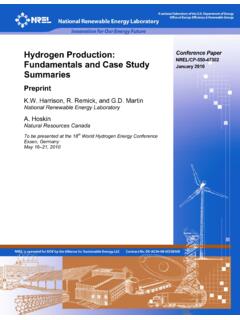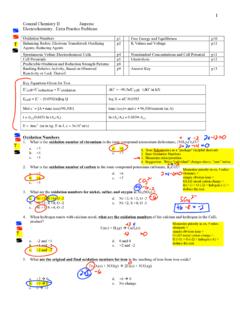Transcription of ElectrElectrochemistrochemistryy ...
1 Unit Objectives Electrochemistry Electrochemistr ochemistr y 3. After studying this Unit, you will be able to describe an electrochemical cell and differentiate between galvanic Chemical reactions can be used to produce electrical energy, conversely, electrical energy can be used to carry out chemical and electrolytic cells ;. reactions that do not proceed spontaneously. apply Nernst equation for calculating the emf of galvanic cell and define standard potential of the cell; Electrochemistry is the study of production of derive relation between standard electricity from energy released during spontaneous potential of the cell, Gibbs energy chemical reactions and the use of electrical energy of cell reaction and its equilibrium to bring about non-spontaneous chemical constant; transformations.
2 The subject is of importance both define resistivity ( ), conductivity for theoretical and practical considerations. A large ( ) and molar conductivity (L m) of number of metals, sodium hydroxide, chlorine, ionic solutions;. fluorine and many other chemicals are produced by differentiate between ionic (electrolytic) and electronic electrochemical methods. Batteries and fuel cells conductivity; convert chemical energy into electrical energy and are describe the method for used on a large scale in various instruments and measurement of conductivity of devices. The reactions carried out electrochemically electrolytic solutions and can be energy efficient and less polluting.
3 Therefore, calculation of their molar study of electrochemistry is important for creating new conductivity; technologies that are ecofriendly. The transmission of justify the variation of sensory signals through cells to brain and vice versa conductivity and molar and communication between the cells are known to conductivity of solutions with change in their concentration and have electrochemical origin. Electrochemistry, is therefore, a very vast and interdisciplinary subject. In define m (molar conductivity at this Unit, we will cover only some of its important zero concentration or infinite elementary aspects. dilution).
4 Enunciate Kohlrausch law and learn its applications;. understand quantitative aspects of electrolysis;. describe the construction of some primary and secondary batteries and fuel cells ;. explain corrosion as an electrochemical process. 2015-16(20/01/2015). 3 . 1 electrochemical In Class XI, Unit 8, we had studied the construction and functioning of Daniell cell (Fig. ). This cell converts the chemical energy liberated cells during the redox reaction Zn(s) + Cu2+(aq) Zn2+(aq) + Cu(s) ( ). to electrical energy and has an electrical potential equal to V when concentration of Zn2+ and Cu2+ ions is unity (1 mol dm 3)*. Such a device is called a galvanic or a voltaic cell.
5 If an external opposite potential is applied in the galvanic cell [Fig. (a)] and increased slowly, we find that the reaction continues to take place till the opposing voltage reaches the value V [Fig. (b)] when, the reaction stops altogether and no current flows through the cell. Any further increase in the external potential again starts the reaction but in the opposite direction [Fig. (c)]. It now functions as an electrolytic cell, a device for using electrical energy to carry non-spontaneous chemical reactions. Both types of cells are Fig. : Daniell cell having electrodes of zinc and quite important and we shall study some of copper dipping in the solutions of their respective salts.
6 Their salient features in the following pages. Eext< Eext = (a) (b). e anode current cathode I=0. Zn salt Cu Zn Cu -ve bridge +ve When Eext = V. (i) No flow of electrons or current. (ii) No chemical ZnSO4 CuSO4 ZnSO4 CuSO4 reaction. When Eext < V Eext > (i) Electrons flow from Zn rod to (c). Cu rod hence current flows from Cu to Zn. When Eext > V. (ii) Zn dissolves at anode and e . (i) Electrons flow copper deposits at cathode. Cathode Current Anode from Cu to Zn +ve ve and current flows Zn Cu from Zn to Cu. Fig. (ii) Zinc is deposited Functioning of Daniell at the zinc cell when external electrode and voltage Eext opposing the copper dissolves at cell potential is applied.
7 Copper electrode. *Strictly speaking activity should be used instead of concentration. It is directly proportional to concentration. In dilute solutions, it is equal to concentration. You will study more about it in higher classes. Chemistry 64. 2015-16(20/01/2015). Galvanic cells As mentioned earlier (Class XI, Unit 8) a galvanic cell is an electrochemical cell that converts the chemical energy of a spontaneous redox reaction into electrical energy. In this device the Gibbs energy of the spontaneous redox reaction is converted into electrical work which may be used for running a motor or other electrical gadgets like heater, fan, geyser, etc.
8 Daniell cell discussed earlier is one such cell in which the following redox reaction occurs. Zn(s) + Cu2+ (aq) Zn2+ (aq) + Cu(s). This reaction is a combination of two half reactions whose addition gives the overall cell reaction: (i) Cu2+ + 2e Cu(s) (reduction half reaction) ( ). 2+ . (ii) Zn(s) Zn + 2e (oxidation half reaction) ( ). These reactions occur in two different portions of the Daniell cell. The reduction half reaction occurs on the copper electrode while the oxidation half reaction occurs on the zinc electrode. These two portions of the cell are also called half- cells or redox couples. The copper electrode may be called the reduction half cell and the zinc electrode, the oxidation half-cell.
9 We can construct innumerable number of galvanic cells on the pattern of Daniell cell by taking combinations of different half- cells . Each half- cell consists of a metallic electrode dipped into an electrolyte. The two half- cells are connected by a metallic wire through a voltmeter and a switch externally. The electrolytes of the two half- cells are connected internally through a salt bridge as shown in Fig. Sometimes, both the electrodes dip in the same electrolyte solution and in such cases we do not require a salt bridge. At each electrode-electrolyte interface there is a tendency of metal ions from the solution to deposit on the metal electrode trying to make it positively charged.
10 At the same time, metal atoms of the electrode have a tendency to go into the solution as ions and leave behind the electrons at the electrode trying to make it negatively charged. At equilibrium, there is a separation of charges and depending on the tendencies of the two opposing reactions, the electrode may be positively or negatively charged with respect to the solution. A potential difference develops between the electrode and the electrolyte which is called electrode potential. When the concentrations of all the species involved in a half-cell is unity then the electrode potential is known as standard electrode potential.
















